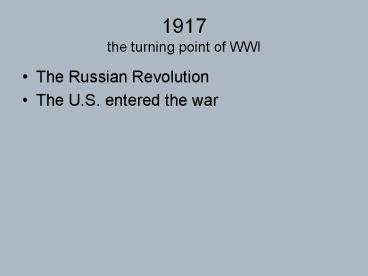1917 the turning point of WWI PowerPoint PPT Presentation
1 / 25
Title: 1917 the turning point of WWI
1
1917 the turning point of WWI
- The Russian Revolution
- The U.S. entered the war
2
- Czar Nicholas II - Autocracy, Orthodoxy
and Nationalism - Unlike his predecessors, he was weak, incompetent
and suspected of being under the influence of his
German-born wife Alexandra, and a half-crazed
monk named Grigori Rasputin.
3
- There were two revolutions in 1917
- The February (March-western calendar)
- The October (November)
4
The November 6th Revolution
- The second revolution was instigated and inspired
by a radical socialist party then known as the
Bolsheviks. Its leader was Vladimir Lenin.
5
World War One The Battle of Tannenberg, 1914
6
(No Transcript)
7
- In 1915, Czar Nicholas decided to go and direct
the war from the front lines - Czarina allowed a crazed monk named Rasputin to
run the homefront
8
(No Transcript)
9
(No Transcript)
10
Demonstrators gathering in front of the Winter
Palace in Petrograd, just prior to the Russian
Revolution, January 1917.
11
- Czar Nicholas abdicated on March 15.A
Provisional Government (the provisional
government is often referred to as the Kerensky
Government ) because its primary figure was
Alexander Kerensky.. - - continued the war- - big mistake that led to
its undoing
12
Vladimir Ulyanov aka Lenin was a folk legend
- A founder of the Bolshevik Party which was
outlawed in Russia. - Lenin had spent 20 years living in exile but
writing about a peoples revolution.
13
Location of Bolshevik Leaders in February, 1917 Location of Bolshevik Leaders in February, 1917
Bolshevik Leaders Location
Lenin Switzerland
Radek Switzerland
Zinoviev Switzerland
Bukharin New York
Litvinov London
Antonov-Ovseenko Paris
Dzerzhinsky Moscow
Latsis Petrograd
Molotov Petrograd
Kirov Vladikavkaz
Stalin Kureika (Siberia)
Ordzhonikidze Pokrovsk (Siberia)
Sverdlov Turukhansk (Siberia)
Kamenev Achinsk (Siberia)
Rykov Narym (Siberia)
14
- Lenin was secretly aided by the German govt to
return to Russia
15
Upon returning to Russia, Lenin promised Peace,
Bread and Land and All Power to the Soviets.
16
The Treaty of Brest-Litovsk, March 1918
- Lenin accepted Germanys harsh conditions in
order to focus on securing powerthe real
revolution was yet to come. - Russia lost 1/3 of its population, 3/4 of its
iron resources and 9/10 of its coal supply plus a
huge indemnity to Germany. - News of the treaty contributed to a civil war
which lasted until 1921.
17
American Entrance into the war
- Woodrow Wilsons
- Proclamation of Neutrality
18
Significance of American entrance into the war
- Turned the tide of battle in favor of the Allies
- Broke sharply with Americas traditional
avoidance of foreign entanglements the policy
of isolation George Washington - Americas emergence as a world power and
eventually a world leader
19
What changed for Americans?
- German unrestricted submarine warfare
- attacked ships of neutral nations without warning
and without attempting to save the crew and
passengers - May 7, 1915 The Lusitania 128 Americans died
20
Allied propaganda
- Americans felt a kinship with the British and
friendship with France since the American
Revolution
21
American economic interests
- American agricultural and manufactured goods were
sold almost exclusively to the Allies. - American investors extended substantial loans to
the Allies
22
American idealism
- a war to end all wars
- the world must be made safe for democracy
- The March Revolution in Russia brought a
democratic govt to Russia
23
April 6, 1917 America goes to war
- The formal end to neutrality came when Congress
passed a formal declaration of war - Wilson offered a peace plan The Fourteen Points
- It took about a year for the U.S. to recruit,
train, supply and transport a modern army to
Europe
24
Hostility towards Germany
- Autocratic Kaiser William
- Invasion of neutral Belgium
- The Lusitania
- Contd submarine warfare
- The Zimmerman telegram
25
- Any questions?

